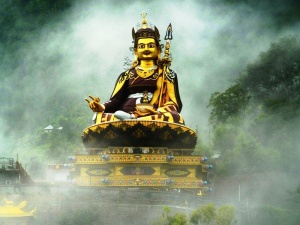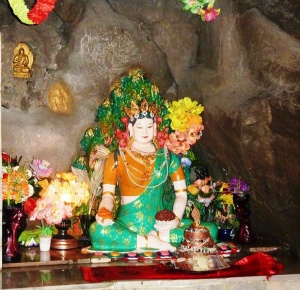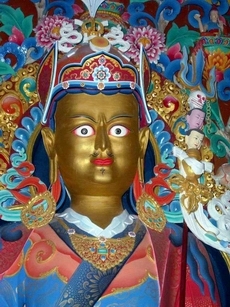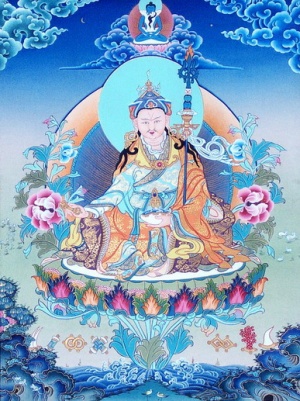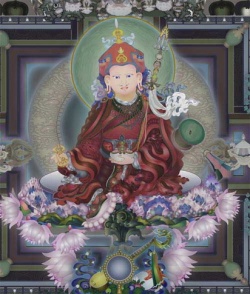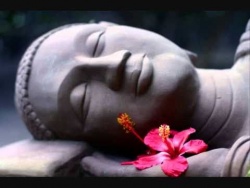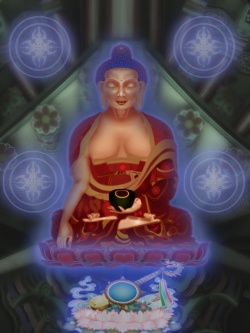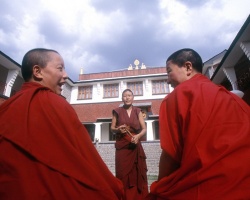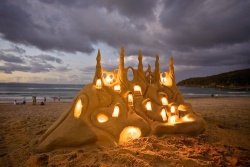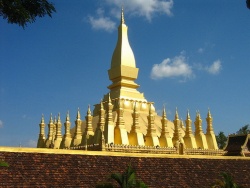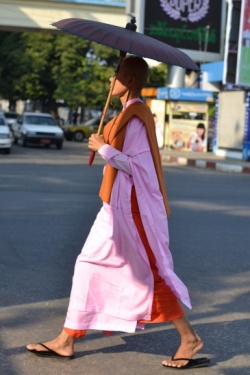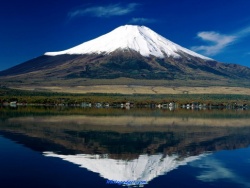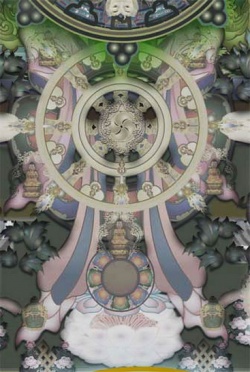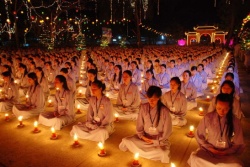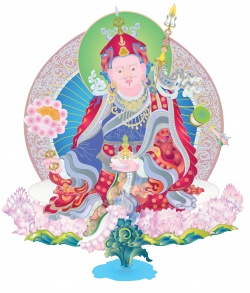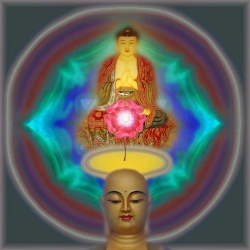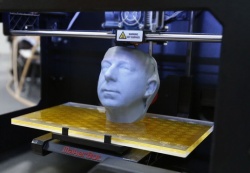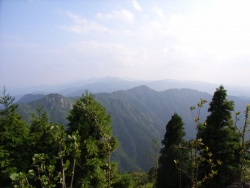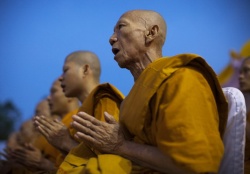Padmasambhava
Padmasambhava Tibetan: པདྨ་འབྱུང་གནས།, Wylie: pad+ma 'byung gnas (EWTS), ZYPY: Bämajungnä); Mongolian ловон Бадмажунай, lovon Badmajunai, Chinese: 蓮花生大士 (pinyin: Liánhuāshēng), meaning "the Lotus-Born," was a sage guru from Oddiyāna who is said to have transmitted Vajrayana Buddhism to Bhutan and Tibet and neighboring countries in the 8th century.
In those lands he is better known as Guru Rinpoche ("Precious Guru") or Lopon Rinpoche, or as Padum in Tibet, where followers of the Nyingma school regard him as the second Buddha.
He is further considered an emanation of Buddha Amitabha and traditionally even venerated as "a second Buddha". He was born into a Brahmin family of Northwest India.
Self-description
Padmasambhava said:
- My father is the intrinsic awareness, Samantabhadra (Sanskrit; Tib. ཀུན་ཏུ་བཟང་པོ).
My mother is the ultimate sphere of reality, Samantabhadri (Sanskrit; Tib. ཀུན་ཏུ་བཟང་མོ).
I belong to the caste of non-duality of the sphere of awareness.
My name is the Glorious Lotus-Born.
I am from the unborn sphere of all phenomena.
I act in the way of the Buddhas of the three times.
His Pureland Paradise is Zangdok Palri (the Copper-coloured Mountain).
Alternative names
- Padmasambhava
- Guru Rinpoche
- Orgyen Guru
- Loppon Rinpoche
- Padum
- Padmakara
- Saroruha Vajra
- Lord Mahaguruji Mei Ling
Life and teachings
According to tradition, Padmasambhava was incarnated as an eight-year-old child appearing in a lotus blossom floating in Lake Dhanakosha,
in the kingdom of Oḍḍiyāna in Ancient India and in modern times identified with the Swat Valley of South Asia present-day Pakistan.
His special nature was recognized by the childless local king of Oḍḍiyāna and was chosen to take over the kingdom but he left Oḍḍiyāna for northern parts of India.
In Rewalsar, known as Tso Pema in Tibetan, he secretly taught tantric teachings to Mandarava who was the local king's daughter.
The king found out and tried to burn him but it is believed when the smoke cleared he was intact and in meditation.
The king offered Padmasambhava his kingdom and Mandarava.
He left with Mandarava and later in Maratika Cave in Nepal, after practicing secret tantric consort rituals, Amitayus appeared and they both achieved immortal bodies in the form of the living rainbow body of the Great Transference (Wylie 'pho ba chen po,
pronounced Phowa Chenpo) which is completely different and much rarer than a dead body dissolving into light or the more usual rainbow body of a living yet mortal human (Wylie: 'ja' lus, pronounced Jalü.) as sometimes still achieved by Dzogchen practitioners of Padmasambhava's terma.
So both Padmasambhava and Mandarava are still believed to be alive and active in Phowa Chenpo form by their followers.
She and Padmasambhava's other main consort, Yeshe Tsogyal who was responsible for hiding his numerous terma later in Tibet became fully enlightened.
Many thangkas and paintings show Padmasambhava in between them.
His fame became known to Trisong Detsen, the 38th king of the Yarlung dynasty, and the first Emperor of Tibet (742–797), whose kingdom was beset by evil mountain deities.
The king invited Padmasambhava to Tibet where he used his tantric powers to subdue the evil deities he encountered along the way, eventually receiving the Emperor's wife, identified with the dakini Yeshe Tsogyal, as a consort.
This was in accordance with the tantric principle of not eliminating negative forces but redirecting them to fuel the journey toward spiritual awakening.
In Tibet he founded the first monastery in the country,
Samye Gompa, initiated the first monks, and introduced the people to the practice of Tantric Buddhism.
Padmasambhava had five major female tantric companions, the so-called 'Five Wisdom Dakinis' (Wylie: Ye-shes mKha-'gro lnga) or 'Five Consorts.'
In Padmasambhava's biography, they are described as the five women "who had access to the master's heart", and practiced tantric rites which are considered to have exorcised the previous demons of Tibet and converted them into protectors of the country.'
They were:
Mandarava of Zahor, the emanation of Vajravarahi's Body;
Belwong Kalasiddhi of (north-west) India, the emanation of Vajravarahi's Quality,
Belmo Sakya Devi of Nepal; the emanation of Vajravarahi's Mind,
Yeshe Tsogyal of Tibet; the emanation of Vajravarahi's Speech and
Mangala or Tashi Kyedren of "the Himalayas", the emanation of Vajravarahi's Activity.
In Bhutan he is associated with the famous Paro Taktsang or "Tiger's Nest" monastery built on a sheer cliff wall about 500m above the floor of Paro valley.
It was built around the Taktsang Senge Samdup (stag tshang seng ge bsam grub) cave where he is said to have meditated in the 8th Century.
He flew there from Tibet on the back of Yeshe Tsogyal, whom he transformed into a flying tigress for the purpose of the trip.
Later he travelled to Bumthang district to subdue a powerful deity offended by a local king.
Padmasambhava's body imprint can be found in the wall of a cave at nearby Kurjey Lhakhang temple.
Padmasambhava also hid a number of religious treasures (termas) in lakes, caves, fields and forests of the Himalayan region to be found and interpreted by future tertöns or spiritual treasure-finders.
According to Tibetan tradition, the [[Bardo Thodol] (commonly referred to as the Tibetan Book of the Dead) was among these hidden treasures, subsequently discovered by a Tibetan terton, Karma Lingpa.
Tantric cycles related to Padmasambhava are not just practiced by the Nyingma, they even gave rise to a new offshoot of Bon which emerged in the 14th century called the New Bön.
Prominent figures of the Sarma (new translation) schools such as the Karmapas and Sakya lineage heads have practiced these cycles and taught them.
Some of the greatest tertons revealing teachings related to Padmasambhava have been from the Kagyu or Sakya lineages.
The hidden lake temple of the Dalai Lamas behind the Potala called Lukhang is dedicated to Dzogchen teachings and has murals depicting the eight manifestations of Padmasambhava.
Padmasambhava established Vajrayana Buddhism and the highest forms of Dzogchen (Mengagde) in Tibet and transformed the entire nation.
On Padmasambhava's consort practice with Princess Sakya Devi from Nepal it is said:
"In a state of intense bliss, Padmasambhava and Sakyadevi realized the infinite reality of the Primordial Buddha Mind, the All-Beneficent Lord (Samantabhadra), whose absolute love is the unimpeded dynamo of existence.
Experiencing the succession of the four stages of ecstasy, their mutual state of consciousness increased from height to height.
And thus, meditating on Supreme Vajrasattva Heruka as the translucent image of compassionate wrathful (energized) activity, they together acquired the mahamudra of Divinity and attained complete Great Enlightenment."
Iconography
The khaṭvāńga, a danda with three severed heads denoting the three kayas (the three bodies of a Buddha: the dharmakaya,
sambhogakaya, and nirmanakaya), crowned by a trishula and dressed with a sash of the Himalayan Rainbow or Five Pure Lights of the Mahabhuta is a particular divine attribute of Padmasambhava and intrinsic to his iconographic representation.
The iconography is utilized in various Tantric cycles by yogis as symbols to hidden meanings in transmitted practices.
Jamyang Khyentse Wangpo briefly describes his iconography as: "His two eyes are wide open in a piercing gaze.
On his body he wears a white vajra undergarment and, on top of this, in layers, a red robe, a dark blue mantrayana tunic, a red monastic shawl decorated with a golden flower pattern, and a maroon cloak of silk brocade.
He has one face and two hands. In his right hand, he holds a five-pronged vajra at his heart; and in his left, which rests in the gesture of equanimity,
he holds a skull-cup in the center of which is a vase of longevity filled with the nectar of deathless wisdom. Cradled in his left arm is a three-pointed khatvanga representing the consort Mandarava.
On his head, he wears a five-petaled lotus hat.
Wrathful and smiling, he blazes magnificently with the splendour of the major and minor marks.
He is seated with his two feet in the royal posture."
Patrul Rinpoche describes it thus: "With his right hand he holds a five-pronged golden vajra at his heart.
In his left hand he holds a skull-cup brimming with nectar, containing the vase of longevity that is also filled with the nectar of deathless wisdom and ornamented on top by a wish-fulfilling tree.
Cradled in his left arm he holds the three-pointed khatvanga (trident) symbolizing the Princess consort (Mandarava).
Its three points represent the essence, nature and compassionate energy (ngowo, rangshyin and tukjé).
Below these three prongs are three severed heads, dry, fresh and rotten, symbolizing the three kayas.
Nine iron rings adorning the prongs represent the nine yanas.
The khatvanga is also adorned with locks of hair from dead and living mamos and dakinis, as a sign that the Master subjugated them all when he practiced austerities in the Eight Great Charnel Grounds.
On his head he wears a lotus hat and on his body he wears a silk cloak, Dharma robes and gown.
His two feet are in the royal posture.
All around him, within a lattice of five-coloured light, appear the eight vidyadharas of India, the twenty-five disciples of Tibet,
the deities of the three roots, and an ocean of oath-bound protectors.
Your visualization should be so vivid that your ordinary perception simply ceases automatically."
[[Image:Guru Rinpoche, Yerpa 1993.JPG|left|thumb|Statue of Guru Rinpoche in his meditation cave at Yerpa, Tibet)] Chökyi Drakpa writes: "
His complexion is white with a tinge of red and he has the youthful appearance of an eight-year old child.
He is wearing the dark blue gown of a mantra practitioner, the red and yellow shawl of a monk, the maroon cloak of a king, and the red robe and secret white garments of a bodhisattva.
He has one face and two hands, and he is seated in royal poise. In his right hand he holds a vajra at his heart, and in his left hand he holds a skull-cup, which contains the vase of immortality, filled with deathless wisdom nectar, in its centre.
On his head he wears a five-petaled lotus hat, which has three points symbolizing the three kayas, five colours symbolizing the five kayas,
a sun and moon symbolizing skilful means and wisdom, a vajra top to symbolize unshakable samadhi, and a vulture's feather to represent the realization of the highest view.
Cradled in his left arm he holds the 'supreme consort', Mandarava, who arouses the wisdom of bliss and emptiness, concealed as the three-pointed khatvanga trident.
The three prongs of the trident symbolize the essence, nature and compassionate energy.
Three severed heads, dry, fresh and rotten, symbolize the dharmakaya, sambhogakaya and nirmanakaya.
Nine iron rings represent the nine yanas and five-coloured strips of silk symbolize the five wisdoms.
The khatvanga is also adorned with locks of hair from dead and living mamos and dakinis, as a sign that they have been subjugated."
The Eight Manifestations
Padmasambhava is said to have taken eight forms or manifestations (Tib. Guru Tsen Gye) representing different aspects of his being: wrath, pacification, etc.:.
According to Rigpa Shedra the eight principal forms were assumed by Guru Rinpoche at different points in his life.
The Eight Manifestations of Padmasambhava belong to the tradition of the Revealed Treasures (Tib.: ter ma).
The vajra-holder (Skt. Vajradhara), shown dark blue in color in the attire of the Sambhogakaya. Depicted in union with consort.
- Guru Shakya Senge (Wylie: shAkya seng-ge, Skrt: Guru Śākyasimha) of Bodh Gaya, Lion of the Sakyas, who learns the Tantric practices of the eight Vidyadharas. He is shown as a fully ordained Buddhist monk.
- Guru Pema Gyalpo (Wylie: gu ru pad ma rgyal-po, Skrt: Guru Padmarāja) of Uddiyana, the Lotus Prince, king of the Tripitaka (the Three Collections of Scripture).
He is shown looking like a young crowned prince or king.
- Guru Pema Jungne (Wylie: pad ma ‘byung-gnas, Skrt: Guru Padmakara) Lotus-arisen, the Saviour who teaches the Dharma to the people.
He is shown sitting on a lotus, dressed in the three robes of a monk, under which he wears a blue shirt, pants and heavy Tibetan boots, as protection against the cold.
He holds the diamond-scepter of compassionate love in his right hand and the yogi's skull-bowl of clear wisdom in his left.
He has a special trident called khatvanga of a wandering Yogi, and wears on his head a Nepalese cloth crown, stylistically designed to remind one of the shape of a lotus flower. Thus he is represented as he must have appeared in Tibet.
- Guru Loden Chokse (Wylie: gu ru blo ldan mchog sred; Skrt: Guru Mativat Vararuci) of Kashmir, the Intelligent Youth, the one who gathers the knowledge of all worlds. He is shown in princely clothes, beating a hand-drum and holding a skull-bowl.
- Guru Nyima Ozer (Wylie: gu ru nyi-ma ‘od-zer, Skrt: Guru Suryabhasa or Sūryaraśmi), the Sunray Yogi, who illuminates the darkness of the mind through the insight of Dzogchen. He is shown as a naked yogi dressed only in a loin-cloth and holding a Khatvanga which points towards the sun.
- Guru Dorje Drolo , (Wylie: gu ru rDo-rje gro-lod, Skrt: Guru Vajra) the fierce manifestation of Vajrakilaya (wrathful Vajrasattva) known as "Diamond Guts", the comforter of all, imprinting the elements with Wisdom-Treasure.
- Guru Senge Dradog (Wylie: gu ru seng-ge sgra-sgrogs, Skrt: Guru Simhanāda) of Nalanda University, the Lion of Debate, promulgator of the Dharma throughout the six realms of sentient beings.
He is shown in a very fierce form, dark blue and imitative of the powerful Bodhisattva Vajrapani, holding a thunderbolt scepter in one hand and a scorpion in the other.
Padmasambhava's various Sanskrit names are preserved in mantras such as those found in the Yang gsang rig 'dzin youngs rdzogs kyi blama guru mtshan brgyad bye brag du sgrub pa ye shes bdud rtsi'i sbrang char zhe bya ba.
The Vajra Guru mantra
- See also: The Syllable by Syllable Commentary Explaining the Benefits and Advantages of the Vajra Guru Mantra
The Vajra Guru (Padmasambhava) mantra OM AH HUM VAJRA GURU PADMA SIDDHI HUM is favoured and held in esteem by sadhakas.
Like most Sanskritic mantras in Tibet, the Tibetan pronunciation demonstrates dialectic variation and is generally OM AH HUNG BENZA GURU PEMA SIDDHI HUNG.
In the Vajrayana traditions, particularly of the Nyingmapa, it is held to be a powerful mantra engendering communion with the Three Vajras of Padmasambhava's mindstream and by his grace, all enlightened beings.
In response to Yeshe Tsogyal's request, the Great Master himself explained the meaning of the mantra although there are larger secret meanings too.
The 14th century tertön Karma Lingpa has a famous commentary on the mantra.
The Seven Line Prayer to Padmasambhava
The Seven Line Prayer to Padmasambhava (Guru Rinpoche) is a famous prayer that is recited by many Tibetans daily and is said to contain the most sacred and important teachings of Dzogchen.
Jamgon Ju Mipham Gyatso composed a famous commentary to the Seven Line Prayer called White Lotus.
It explains the meanings, which are embedded in many levels and intended to catalyze a process of realization.
These hidden teachings are described as ripening and deepening, in time, with study and with contemplation.
Tulku Thondup says:
- Enshrining the most sacred prayer to Guru Padmasambhava, White Lotus elucidates its five layers of meaning as revealed by the eminent scholar Ju Mipham.
This commentary now makes this treasure, which has been kept secret among the great masters of Tibet for generations, available as a source of blessings and learning for all.
There is also a shorter commentary, freely available, by Tulku Thondup himself.
There are many other teachings and Termas and widely practiced tantric cycles incorporating the text as well as brief ones such as Terma Revelation of Guru Chöwang.
Life story of Guru Rinpoche according to Jamgon Kongtrul
The following is a short life story of Guru Rinpoche, also referred to as Padmakara in the text, extracted from the "Precious Garland of Lapis Lazuli", a collection of life stories of the 108 main termas written by Jamgon Kongtrul the First and found in Volume I of his Treasury of Precious Termas called the Rinchen Terdzod.
Rinchen Terdzod is a highly revered and widely practiced set of historic Sadhanas and Terma practice cycles and commentaries which was envisioned by Rimé movement founders and compiled mainly by Kongtrul:
"Padmakara has influenced countless beings through the Vajrayana teachings and in particular through the activity of the profound terma treasures.
This great master was not an ordinary person on the path or just a noble being on one of the bodhisattva bhumis but an emanation of both Buddha Amitabha and Shakyamuni who appeared in order to tame the human beings and spirits difficult to convert.
Even the great bodhisattvas are incapable of fully explaining his life example but in brief I will narrate it as follows:
In the dharmakaya realm of the Luminous Vajra Essence he has by nature attained perfect enlightenment since the very beginning as the liberated ground of primordial purity.
He is renowned as the original protector, Unchanging Light.
In the self-manifest sambhogakaya realm of the Thunder of the Drum of Perfection, he spontaneously manifested as the boundless wisdom array of the five families of Buddha Immense Ocean possessing the five certainties.
As the external manifestation of this self-appearing display, in the countless sceneries of bodily forms in buddhafields of the five families consisting of the semi-manifest natural nirmanakaya realms of Mahabrahma,
he appears to all the bodhisattvas on the ten bhumis.
Since these all are the cloud banks of Guru Rinpoche's wisdom display, the 'inexhaustible wheel of adornment,' he is known as the All-Holding Lotus.
By the power of these wisdom displays he appears in countless worlds of the ten directions as the magical apparition of nirmanakayas who tame beings.
In particular, it is taught that only in this Saha world-system he illuminates fifty worlds with the lamp of the teachings of Sutra and Tantra appearing as the eight manifestations to tame beings in the different parts of the world.
The Dakini Yeshe Tsogyal had a vision in which she saw a manifestation of Guru Rinpoche called Immense Vajra Ocean in the direction to the east.
Each of the pores in his body held one billion realms and in each realm there were one billion world systems.
In each of these world systems there were one billion Guru Rinpoches who each created one billion emanations.
Each of these emanations carried out the activity of taming one billion disciples.
She then saw the same display in each of the other directions and in the center.
In this world of Jambudvipa, Guru Rinpoche is known as just one nirmanakaya who tames beings but according to the different capacities and giftedness of people he is perceived in various ways.
The history of the Oral Transmission of Kilaya and most Indian sources explain that he was born as the son of a king or a minister in Uddiyana; while the terma treasures for the most part narrate that he was miraculously born.
In some texts he is said to have appeared from a bolt of lightning at the summit of Mount Malaya.
Each of these wondrous stories differ in many ways.
This is indeed a topic that lies far beyond the reach of an ordinary person's intellect.
I shall now limit the explanation down to a mere seed, the life of Guru Rinpoche according to miraculous birth as it appears in the terma teachings:
In the land of Uddiyana situated to the west of Bodhgaya there was an island in a huge lake on which appeared a multicolored lotus flower through the blessings of the buddhas.
Buddha Amitabha sent from his heart center a golden vajra marked with the letter HRIH into the bud of this lotus flower which miraculously turned into a small child eight years of age holding a vajra and a lotus and adorned with the major and minor marks.
The child remained there teaching the profound Dharma to the devas and dakinis on the island.
At that time Indrabodhi, who was the king of the country, had no sons.
He had already emptied out his treasury by making offerings to the Three Jewels and giving alms to the poor.
As a last resort, in order to find a wish-fulfilling jewel he embarked on a journey with his minister Krishnadhara on the great lake.
On their return first Krishnadhara and later King Indrabodhi met the miraculous child.
The king regarded him as an answer to his prayers for a son and brought him to the palace where he was given the name Padmakara, the Lotus-Born.
Padmakara was then asked to sit on a throne made of precious gems and given lavish offerings by all the people.
The prince grew up, bringing countless beings to maturation through his youthful sports and games.
He married Prabhadhari and ruled the kingdom of Uddiyana in accordance with the Dharma.
At that time he perceived that he would be unable to accomplish the immense welfare of other beings by governing a country so he asked Indrabodhi permission to leave which was not granted.
In an act of play, he then pretended that his trident slipped out of his hand.
It fell and killed the son of one of the ministers.
He was then sentenced to be expelled to a charnel ground.
He remained in Cool Grove, Joyful Forest and Sosaling, engaging in the conduct of yogic disciplines.
During this time he received empowerment and blessings from the two dakinis Tamer of Mara and Sustainer of Bliss.
When bringing all the dakinis of the charnel grounds under his command, he was known as Shantarakshita.
Padmakara returned to Uddiyana, to the island in Lake Danakosha where he practiced Secret Mantra and the symbolic language of the dakinis through which he brought the dakinis on the island under his command.
He then practiced in the Rugged Forest and was blessed with a vision of Vajra Yogini.
He bound under oath all the nagas of the lakes as well as the planetary spirits and was invested with supernatural powers by all the dakas and dakinis.
Thus he became renowned as Dorje Drakpo Tsal, Wrathful Vajra Power.
He then journeyed to the Vajra Throne in Bodhgaya where he showed many miracles.
People asked who he was and when he replied that he was a self-appeared buddha they did not believe but instead defamed him.
Seeing the many reasons to have a teacher, he went to Zahor where he took ordination from Prabhahasti and was given the name Shakya Senge Lion of the Shakyas.
He received the teaching on Yoga Tantra eighteen times and had visions of the deities.
Then he went to the female master Kungamo who was the wisdom dakini Guhya Jñana appearing in the form of a nun.
He asked for empowerment and she changed him into the letter HUNG which she then swallowed and emitted through her lotus.
Inside her body he was bestowed the entire outer, inner and secret empowerments and purified of the three obscurations.
Later, he met the eight great knowledge-holders and received the Eight Sadhana Sections.
He received the Magical Net from the great master Buddha Guhya and Dzogchen from Shri Singha.
In this way he studied and received all the sutras, tantras and sciences from numerous learned and accomplished masters of India.
He became adept by learning a topic just once and had visions of all the deities even without practicing.
At this time he was known as Loden Choksey and he displayed the manner of perfecting the vidyadhara level of maturation.
He then went to the country of Zahor where he magnetized Mandarava, a qualified dakini who was the daughter of King Vihardhara.
Taking her as his sadhana support, they practiced for three months in the Maratika Cave after which Buddha Amitayus appeared in person, conferred empowerment upon them and blessed them to be inseparable from himself.
They were given one billion tantras on longevity and accomplished the vidyadhara level of life-mastery.
Having attained the vajra body beyond birth and death, they went back to teach the kingdom of Zahor.
[While] begging for alms, they were arrested by the king and his ministers and burned alive.
The master and his consort inspired faith by displaying the miracle of transforming the pyre into a cool lake in the center of which they sat on a lotus flower.
They caused all the people to embrace Dharma practice and established them in the state beyond falling back into samsara.
Padmakara then returned to convert the people of Uddiyana.
While begging for alms, he was recognized and burned in a huge pyre of sandalwood.
The master and his consort again appeared unharmed on a lotus flower in the center of a lake wearing a garland of skulls to symbolize liberating all sentient beings from samsara.
Because of showing this miracle he was then renowned as Padma Tötreng Tsal, Powerful Lotus of the Garland of Skulls.
He remained in Uddiyana for 13 years as the king's teacher and established the whole kingdom in Dharma practice.
During this time he gave the empowerment and teachings for the Dharma Ocean Embodying All Teachings (Kadü Chökyi Gyamtso), through which the king and queen as well as all the destined ones accomplished the supreme vidyadhara level.
He was then known as Padma Raja, the Lotus King.
In accordance with a prophecy in the Sutra on Magical Perception, Padmakara transformed himself into the monk Wangpo Dey in order to convert King Ashoka.
Having established Ashoka in unshakable faith, during a single night he erected in this world one million stupas containing the relics of the Tathagata.
He also subdued several non-Buddhist teachers, was poisoned by one king but remained unharmed.
When he then was thrown into the river he made the river flow upstream and danced about in mid-air.
Through that he became known as Powerful Garuda Youth.
Moreover, Padmakara manifested himself in the form of Acharya Padmavajra, the master who revealed the Hevajra Tantra, as well as the Brahmin Saraha, Dombi Heruka, Virupa, Kalacharya and many other siddhas.
He practiced in the great charnel grounds where he taught the Secret Mantra to the dakinis.
He subdued the outer and inner mundane spirits and named them protectors of the Dharma.
At that time he became known as Nyima Özer [Skt. Suryaprabha).
When five hundred Non-Buddhist teachers were about to defeat the Dharma in debate at Bodhgaya, Padmakara challenged them and was victorious.
Some of the teachers resorted to evil spells, but Padmakara scattered them by means of a wrathful mantra given by the dakini Tamer of Mara.
The rest converted to Buddhism and the banner of the Dharma was raised to the skies.
At that time he became known as Senge Dradrok (Lion's Roar.]
Up to this point he had exhausted the three defilements and resided on the vidyadhara level of life-mastery, the stage of having fully perfected the supreme path.
Proceeding to the cave of Yangleshö situated between India and Nepal he met Shakya Devi, the daughter of a Nepalese King, whom he accepted as his sadhana support and consort.
While practicing Vishuddha Heruka three powerful spirits created obstacles, preventing rainfall for three years and causing disease and famine.
Padmakara sent messengers to India asking his masters for a teaching that could counteract these obstacles.
Two men returned loaded with Kilaya scriptures and the obstacles were spontaneously pacified the very moment they arrived with the scriptures in Nepal.
Padmakara and his consort then attained the supreme siddhi and abided on the vidyadhara level of mahamudra.
Guru Rinpoche perceived that the practice of Vishuddha Heruka brings great accomplishment.
But that practice is like a traveling trader who meets with many hindrances, whereas Kilaya is like an indispensable escort.
Due to this coincidence Guru Rinpoche he composed many sadhanas combining the two herukas.
At this place he also bound under oath the sixteen mundane protectors of Vajra Kilaya.
Padmakara visited other ancient kingdoms where he taught the Dharma:
Hurmudzu in the vicinity of Uddiyana, Sikojhara, Dharmakosha, Rugma, Tirahuti, Kamarupa, and Kancha, as well as many others.
It is not sure when he went to the land of Droding, but the tantric teachings he gave there on Hevajra, Guhyachandra Bindu, Vishuddha, Hayagriva, Kilaya and Mamo are still continued this present day.
Padmakara is generally regarded to have lived in India for 3600 years benefiting the teachings and sentient beings.
But it seems that learned people accept that to be half-years and simply a generalization.
In order to convert people in Mongolia and China Padmakara emanated in the form of the King Ngonshe Chen and the yogi Tobden.
Moreover, he appeared in the country of Shangshung as the miraculously born child Tavi Hricha who gave the instructions on the hearing lineage of Dzogchen and led many worthy disciples to the attainment of the rainbow body.
In this way Padmakara's activity for bringing people to the path of liberation by means of appearing in various places, in various forms, speaking various languages is indeed beyond measure.
Now I will describe how Padmakara came here to the land of Tibet: When King Trisong Deutsen, himself an emanation of Manjushri, was twenty years of age he formed a strong aspiration to spread the sacred teachings of the Dharma.
He invited Khenpo Bodhisattva from India who taught the doctrine of dependent origination and the ten virtuous actions.
A year later the foundation was laid for a huge temple but the spirits of Tibet created obstacles and prevented the building.
In accordance with the Khenpo's prediction, the king sent five runners to invite the great master Padmakara to come.
Having foreknowledge of this, Padmakara had already gone to Mang-Yül between Nepal and Tibet.
On the way to Central Tibet, he went via Ngari, Tsang and Dokham and miraculously visited all of the districts where he bound under oath (Samaya?)the 12 Tenma Goddesses, the 13 Gurlha and 21 Genyen as well as many other powerful spirits.
At the Tamarisk Forest at Red Rock he met the king of Tibet where he proceeded to the top of Hepori to bring the gods and demons under his command.
He laid the foundation for Samye and saw it through to completion, employing also the gods and demons who had earlier hindered the building.
In five years the work was completed for the temple complex of Glorious Samye, the Unchanging and Spontaneously Accomplished Temple, including the three temples of the queens, which was built to resemble Mount Sumeru surrounded by the four continents, eight subcontinents, sun and moon, and the wall of iron mountains.
During the consecration ceremony five wondrous signs occurred.
The king then wished to translate the scriptures and establish the Dharma so he had many intelligent Tibetan boys study to become translators.
Inviting other masters of the Tripitaka from India, he had the Khenpo ordain the first seven monks and gradually establish an ordained sangha.
The Khenpo Bodhisattva and Padmakara and the other panditas together with Vairochana, Kawa Paltseg and Chog-ro Lui Gyaltsen and the other translators then rendered into Tibetan all the existent Buddhist scriptures on Sutra and Tantra as well as most of the treatises explaining them.
Vairotsana and Namkhai Nyingpo were sent to India where Vairotsana studied Dzogchen with Shri Singha while Namkhai Nyingpo received the teachings on Vishuddha Heruka from the great master Hungkara.
They both attained accomplishment and spread the teachings in Tibet. King Trisong Deutsen then requested empowerment and instruction from Padmakara.
At Chimphu, the hermitage above Samye, the great master disclosed the mandala of Eight Heruka Sadhanas into which he initiated nine chief disciples including the king.
Each of them were entrusted with a specific transmission and all nine attained siddhi through practicing the respective teaching.
Padmakara gave numberless other profound and extraordinary teachings connected with the three inner tantras to many destined students headed by the king and his sons and the 25 disciples in Lhodrak, Tidro and many other places.
Guru Rinpoche remained in Tibet for 55 years and six months; 48 years while the king was alive and seven years and six months afterwards.
He arrived when the king was 21 (810 A.D.).
The king passed away at the age of 69. Padmakara stayed for a few years after that before leaving for the land of the rakshas.
Padmakara visited in person the 20 snow mountains of Ngari, the 21 places of practice in Central Tibet and Tsang, the 25 sacred places of Dokham, the three hidden valleys, and numerous other places each of which he blessed to be a sacred place of practice.
Knowing that a descendant of the king would later try to destroy Buddhism in Tibet, he gave many predictions for the future.
Conferring with the king and the close disciples, Padmakara concealed countless terma teachings headed by the eight personal treasures of the king, the five great mind treasures, and the 25 profound treasures.
The reasons for hiding these termas were to prevent the teachings of Secret Mantra to be destroyed, to avoid [...] the Vajrayana's [being] corrupted or modified by intellectuals, to preserve the blessings and to benefit future disciples.
For each of these hidden treasures Padmakara predicted the time of the disclosure, the person who would reveal them, and the destined recipients who would hold the teachings.
He manifested in the terrifying wrathful form of crazy wisdom in the thirteen places named Tiger's Nest binding all the mundane spirits under oath to serve the Dharma and entrusted them to guard the terma treasures.
At that time he was named Dorje Drollö.
To inspire faith in future generations, he left an imprint of his body at Bumtang, handprints at Namtso Chugmo and footprints at Paro Drakar as well as in innumerable other places of practice.
After the death of King Trisong Deutsen, Padmakara placed Mutig Tsenpo on the throne.
He performed a drubchen at Tramdruk where he entrusted the profound teachings to Gyalsey Lhaje, the second prince, and gave him the prophecy that he would benefit beings by becoming a revealer of the hidden treasures in thirteen future lives.
It is impossible to count exactly how many students in Tibet received empowerment from Padmakara in person, but the most renowned are the original 25 disciples, the intermediate 25 disciples and the later 17 and 21 disciples.
There were 80 of his students who attained rainbow body at Yerpa and also the 108 meditators at Chuwori, the 30 tantrikas at Yangdzong,
the 55 realized ones at Sheldrag. Of female disciples there were the 25 dakini students and seven yoginis. Many of these close had bloodlines that have continued until the present day.
When about to leave for the land of rakshas to the southwest, the king, the ministers and all the disciples tried to dissuade Padmakara from parting but to no avail.
He gave each of them extensive advice and teachings and departed from the pass of Gungtang, riding on a horse or a lion, accompanied by numerous divine beings making offerings.
At the summit of the Glorious Copper-colored Mountain on the Chamara continent he liberated Raksha Tötreng, the king of the rakshas, and assumed his form.
After that, he miraculously created the palace of Lotus Light endowed with inconceivable decorations and also emanated a replica of himself on each of the surrounding eight islands where they reside as kings who teach the eight heruka sadhanas.
At present he dwells on the vidyadhara level of spontaneous presence in the form of the regent of Vajradhara, unshakable for as long as samsara remains.
Full of compassion he sends out emanations to benefit beings.
Even after the teachings of the Vinaya have perished he will appear among the tantric practitioners. There will be many destined disciples who attain rainbow body.
In the future, when Buddha Maitreya appears in this world, Padmakara will emanate as Drowa Kundul and spread the teachings of Secret Mantra to all worthy people."
Translated by the Erik Pema Kunsang, and included in Dakini Teachings, © Rangjung Yeshe Publications, 1990.
There are many biographies of Padmasambhava in various Tibetan texts.
Twenty-five main disciples
Twenty-five Main Disciples of Padmasambhava (Tibetan: རྗེ་འབངས་ཉེར་ལྔ, Wylie: rje 'bangs nyer lnga) -also called the disciples of Chimphu- in various lists these include:
- King Trisong Detsen (Tibetan: ཁྲི་སྲོང་ལྡེའུ་བཏཟན, Wylie: khri srong lde'u btzan)
- Denma Tsémang (Tibetan: ལྡན་མ་རྩེ་མང, Wylie: ldan ma rtse mang)
- Dorje Dudjom of Nanam (Tibetan: རྡོ་རྗེ་བདུད་འཇོམ, Wylie: rdo rje bdud 'joms)
- Khyechung Lotsawa (Tibetan: ཁྱེའུ་ཆུང་ལོ་ཙཱ་བ, Wylie: khye'u chung lo tsā ba)
- Gyalwa Changchub of Lasum (Tibetan: ལ་སུམ་རྒྱལ་བ་བྱང་ཆུབ, Wylie: la sum rgyal ba byang chub)
- Gyalwa Choyang (Tibetan: རྒྱལ་བ་མཆོག་དབྱངས, Wylie: rgyal ba mchog dbyangs)
- Gyalwe Lodro of Dré (Tibetan: རྒྱལ་བའི་བློ་གྲོས, Wylie: rgyal ba'i blo gros)
- Jnanakumara of Nyak (Tibetan: གཉགས་ཛཉའ་ན་ཀུ་མ་ར, Wylie: gnyags dzny' na ku ma ra)
- Kawa Paltsek (Tibetan: སྐ་བ་དཔལ་བརྩེགས, Wylie: ska ba dpal brtsegs)
- Khandro Yeshe Tsogyal, the princess of Karchen (Tibetan: མཁར་ཆེན་བཟའ་མཚོ་རྒྱལ, Wylie: mkhar chen bza' mtsho rgyal)
- Konchog Jungné of Langdro (Tibetan: ལང་གྲོ་དཀོན་མཆོག་འབྱུང་གནས, Wylie: lang gro dkon mchog 'byung gnas)
- Lhapal the Sokpo (Tibetan: སོག་པོ་ལྷ་དཔལ, Wylie: sog po lha dpal)
- Namkhai Nyingpo (Tibetan: ནམ་མཁའི་སྙིང་པོ, Wylie: nam mkha'i snying po)
- Zhang Yeshe De (Tibetan: ཞང་ཡེ་ཤེས་སྡེ, Wylie: zhang ye shes sde)
- Palgyi Dorje of Lhalung (Tibetan: ལྷ་ལུང་དཔལ་གྱི་རྡོ་རྗེ, Wylie: lha lung dpal gyi rdo rje)
- Palgyi Senge (Tibetan: དཔལ་གྱི་སེང་གེ, Wylie: dpal gyi seng ge)
- Palgyi Wangchuk (Tibetan: དཔལ་གྱི་དབང་ཕྱུག, Wylie: dpal gyi dbang phyug)
- Palgyi Wangchuk of Odren (Tibetan: འོ་དྲན་དཔལ་གྱི་དབང་ཕྱུག, Wylie: 'o dran dpal gyi dbang phyug)
- Palgyi Yeshe (Tibetan: དཔལ་གྱི་ཡེ་ཤེས, Wylie: dpal gyi ye shes)
- Rinchen Chok of Ma (Tibetan: རྨ་རིན་ཆེན་མཆོག, Wylie: rma rin chen mchog)
- Sangye Yeshe (Tibetan: སངས་རྒྱས་ཡེ་ཤེས, Wylie: sangs rgyas ye shes)
- Shubu Palgyi Senge (Tibetan: ཤུད་བུ་དཔལ་གྱི་སེང་གེ, Wylie: shud bu dpal gyi seng ge)
- Vairotsana, the great translator (Tibetan: བཻ་རོ་ཙ་ན, Wylie: bai ro tsa na)
- Yeshe Yang (Tibetan: ཡེ་ཤེས་དབྱངས, Wylie: ye shes dbyangs)
- Yudra Nyingpo of Gyalmo (Tibetan: ག་ཡུ་སྒྲ་སྙིང་པོ, Wylie: g.yu sgra snying po)
Also:
- Vimalamitra (Tibetan: དྲུ་མེད་བཤེས་གཉེན, Wylie: dru med bshes gnyen)
- Tingdzin Zangpo (Tibetan: ཏིང་འཛིན་བཟང་པོ, Wylie: ting 'dzin bzang po)
Guru Rinpoche in popular culture
In September 2010, bluegrass musician Peter Rowan and his band released the album Legacy that features a kind of 'Buddhist gospel bluegrass' song about Guru Rinpoche, titled "Across the Rolling Hills."
This track – number 13 on the CD – ends with a chant that is, presumably, a variation on the Padmasambhava mantra, sung in full harmony by the band. The lyrics include the words "I sing a song of freedom for every living being."
Source
Padmasambhava[1] (Skt.), or Padmakara (Skt. Padmākara; Tib. པདྨཱ་ཀ་ར་, པདྨ་འབྱུང་གནས་, Pemajungné; Wyl. pad+ma 'byung gnas, in Sanskrit transliteration པདྨ་སམྦྷ་ཝ་) means ‘Lotus-born’,
which refers to Guru Rinpoche's birth from a lotus in the land of Oddiyana. Guru Rinpoche, the ‘Precious Master’, is the founder of Tibetan Buddhism and the Buddha of our time.
Whereas Buddha is known primarily for having taught the teachings of the sutra vehicle, Padmasambhava came into this world, and to Tibet in particular, in order to teach the tantras.
While Buddha Shakyamuni exemplifies the buddha principle, the most important element in the sutrayana path, Padmasambhava personifies the guru principle, the heart of Vajrayana Buddhism, and he is therefore known as the ‘second Buddha’ (Tib. སངས་རྒྱས་གཉིས་པ་, sangyé nyipa).
Biography
Birth
In the north-western part of the land of Oddiyana, on an island in the lake of Dhanakosha, the blessings of all the buddhas took shape in the form of a multi-coloured lotus flower.
Moved by compassion at the suffering of sentient beings, the Buddha Amitabha sent out from his heart a golden vajra, marked with the syllable HRIH, which descended onto the lotus blossom.
It transformed into an exquisitely beautiful eight year old child, endowed with all the major and minor marks of perfection, and holding a vajra and a lotus.
At that moment all the buddhas of the ten directions, together with hundreds of thousands of dakinis from different celestial realms, invoked the blessings and the incarnation of all the buddhas for the benefit of beings and the flourishing of the secret mantra teachings. Their invocation is known as ‘The Seven Verses of the Vajra’, or ‘The Seven Line Prayer’.
It is said that his birth took place in the year of the Earth Monkey, on the tenth day of the waxing moon in the monkey month.
As Guru Rinpoche was born within the lotus flower upon the waters of the lake, the dakinis called out to him from their hearts, and their call spontaneously became the Vajra Guru mantra.
So this mantra is his heart mantra, his life-core, his heart essence, and to recite it is to invoke his very being.
It happened that at that time, the King of Oddiyana, Indrabhuti, as a result of his immense generosity to the poor and needy of his country, had finally emptied his treasury.
In addition, he had no heir to succeed him as ruler, and his sight had failed him.
So he had set out on a voyage on the lake of Dhanakosha to find a wishfulfilling jewel.
As he returned with the jewel, he encountered the amazing child, and questioned him about his parents, his family line, his name and country, his sustenance and what he was doing there.
The boy sang his reply in an enchanting voice:
- My father is the pure awareness of rigpa, Samantabhadra,
- My mother, the space of all things, Samantabhadri,
- My line, the indivisibility of awareness and space,
- My name, the glorious Lotus-born,
- My homeland, the unborn dharmadhatu,
- My sustenance, consuming dualistic thoughts,
- My destiny, to accomplish the actions of the buddhas of past, present and future.
[[Image:Padmasambhava.jpg|thumb|Guru Padmasambhava, from a set of thangkas depicting his eight manifestations)]
Indrabhuti took him back to the kingdom and installed him as the crown prince.
At different points in his life, Guru Rinpoche is known by different names.
Now he was known as Pemajungné, Padmakara or Padmasambhava, ‘The Lotus-born’, as well as Tsokyé Dorjé, ‘Lake Born Vajra’.
Marriage and Exile
Padmasambhava married the dakini Prabhavati and ruled the kingdom according to the Dharma, ushering in a time of happiness and peace.
He was known then as King Tortokchen, ‘The Turbaned King’.
Seeing that as a ruler he would be unable truly to serve others and bring them spiritual benefit on a vast scale, he begged for permission to abdicate, but was refused.
So Padmasambhava employed a skilful device in order to escape.
Perceiving that a harmful minister’s son was just on the point of dying and being reborn in the lower realms, he dropped his trident while dancing on the palace roof, and it caused the death of the child, who was liberated and reborn in a buddha realm.
Padmasambhava was banished, and roamed in ‘The Chilly Grove’, Shitavana, charnel ground, and then in the other charnel grounds, ‘Joyous Grove’ and Sosadvipa.
There, he received empowerments and blessings from the dakinis ‘Tamer of Mara’ and ‘Sustainer of Bliss’, and practised yogic disciplines, bringing the dakinis of the charnel grounds under his sway.
The name he was known by was Shantarakshita, ‘Preserver of Peace’.
Returning to the island in Lake Dhanakosha, Padmasambhava brought its dakinis under his command.
Then, in ‘The Rugged Forest’ Parushakavana charnel ground, Vajravarahi appeared to him, and blessed him.
He subdued nagas of the oceans and planetary spirits of the heavens; wisdom dakas and dakinis granted him supernatural powers and siddhis, and he was known as Dorjé Drakpo Tsal, ‘Wrathful Vajra Might’.
In Zahor
At ‘the Vajra seat’ in Bodhgaya, he displayed miracles, acknowledging he was a self-manifested buddha, and then he went to the land of Zahor.
Although Padmasambhava was a fully enlightened buddha, he appeared as a nirmanakaya manifestation to tame and teach beings in this age, and so for their benefit he acted as if receiving teachings, accomplishing the practice and passing through the various stages of spiritual realization, one by one.
Some accounts tell how in Vajrasana, he was ordained by the Buddha’s closest disciple, Ananda.
Others say he took ordination from Prabhahasti in Zahor, and was given the name Shakya Sengé, ‘Lion of the Shakyas’.
He received the teachings on Yoga Tantra from him eighteen times, and experienced pure visions of the deities.
Then he received empowerment from the wisdom dakini Kungamo, also known as Khandroma Lékyi Wangmo, who transformed him into a
syllable HUNG, swallowed him, and passed him through her body and out through her secret lotus, granting him outer, inner and secret empowerments, and purifying the three obscurations.
From the eight vidyadharas at Deché Tsekpa, he received the teachings on the eight great sadhanas of Kagyé, from Buddhaguhya the teachings
on ‘The Secret Essence Tantra’, and from Shri Singha the teachings of Dzogpachenpo. Padmasambhava would master a teaching the first time he encountered it, and experienced visions of deities without needing to practise.
Attaining the first vidyadhara level, the stage of ‘the vidyadhara level of maturation’ or ‘vidyadhara with karmic residue’, Guru Rinpoche was known as Loden Choksé, ‘Wise Seeker of the Sublime’.
Returning to Zahor, Padmasambhava took the royal princess Mandarava as his consort, and they then went to the Maratika cave, where for three months they practised the sadhana of longevity.
The Buddha of Limitless Life, Amitayus appeared, empowered them with longevity, and blessed them as inseparable from him.
They both accomplished the second vidyadhara level, ‘vidyadhara with mastery over life’.

The king of Zahor and his ministers arrested Guru Rinpoche and Mandarava and burned him alive, but he transformed the pyre into a lake, and was found sitting, cool and fresh, on a lotus blossom in its centre.
This lake is considered to be the Rewalsar Lake, ‘Tso Pema’, in the present-day Indian state of Himachal Pradesh.
Overcome with remorse, and in homage, the king offered Padmasambhava his entire kingdom, beginning with his garments and his five royal robes. In paintings and statues, Guru Rinpoche is portrayed wearing the clothing of the king of Zahor.
For example, the hat offered by the king is called The Lotus which Liberates on Sight, or The Petalled Hat of the Five Families; its inner and outer layers symbolize the unity of generation and completion phases, its three points the three kayas,
its five colours the five kayas working for the benefit of beings, the sun and moon skilful means and wisdom,
its blue border unlimited samaya, the vajra top unshakeable concentration and the vulture’s feather the realization of the highest view and the culmination of the practice.
Guru Rinpoche taught the king and subjects of Zahor, and many attained realization.
With Mandarava, he then returned to Oddiyana, but was recognized, and burned on a sandalwood pyre.
After some time, they were found seated on a lotus in a lake of sesame oil, wearing a garland of skulls, as a symbol of their liberating all beings from samsara through compassion.
Padmasambhava was now known as Pema Thötreng Tsal,
‘The Powerful Lotus-born, with a Garland of Skulls’.
For thirteen years Padmasambhava and Mandarava remained to teach in Oddiyana, as a result of which the king, queen and many others attained realization and the rainbow body.
Then Padmasambhava was known as Padma Raja—Pema Gyalpo—, ‘The Lotus-born King’.
Manifesting himself as the monk Indrasena, it is said that Padmasambhava inspired the great king, Ashoka (3rd century BC), to have faith in the Buddhadharma.
After defeating various anti-Buddhist rulers, Guru Rinpoche was poisoned, but remained unharmed, and he was thrown in the Ganges, but made the river flow upstream and danced in the air, therefore earning the name of Khyeu Khanding Tsal,
‘Mighty Youth, Soaring in the Sky like a Garuda’.
He manifested as a number of great siddhas, such as Saroruha, Saraha, Dombi Heruka, Virupa and Krishnacharya.
In charnel grounds like Kuladzokpa, ‘Perfected in Body’, he taught the secret mantra to dakinis, and made outer and inner spirits into protectors of the Dharma.
He was then known as Nyima Özer, ‘Rays of the Sun’.
Padmasambhava challenged and defeated five hundred upholders of wrong views in debate at Bodhgaya.
He reversed their magic with the aid of a wrathful mantra given him by the lion-faced dakini Marajita.
He was known as Senge Dradok, ‘The Lion’s Roar’.
At Yangleshö
[[Image:YangleshoGuruRinpocheCave.jpg|thumb|201px|Guru Rinpoche statue inside the cave at Yangleshö)] Then at Yangleshö, present day Pharping in Nepal, he practised the sadhana of Yangdak Heruka with the consort Shakyadevi, daughter of a king of Nepal.
Powerful spirits caused a three year drought, with famine and disease, and Padmasambhava asked his teachers in India for a teaching to counter them.
Two men returned, laden with the tantras and commentaries of Vajrakilaya, and the moment they
arrived, the obstacles were pacified. Guru Rinpoche and Shakyadevi both attained the third vidyadhara level,
‘vidyadhara of the great seal, or mahamudra’.
Guru Rinpoche recognized that Yangdak is like a merchant engaging in trade—the achievement can be great, but so can the obstacles, whereas Vajrakilaya is like an armed escort; he is needed to guard against obstacles and overcome them.
He then composed sadhanas of Yangdak and Vajrakilaya combined, and bound the guardians of Vajrakilaya to protect the teachings.
As for the Dzogchen teachings, it is said that Padmasambhava met Garab Dorje in a pure vision, and he also received the Nyingtik teachings from Manjushrimitra.
As Nyoshul Khen Rinpoche explains in his ‘History of the Natural Dzogpachenpo’ A Marvellous Garland of Rare Gems, Guru Rinpoche travelled to the Parushakavana charnel ground where Shri Singha granted him the teachings of the Three Classes of Mind, Space and Pith Instructions.
After granting him the Outer, Inner and Secret cycles, Shri Singha conferred on Padmasambhava the teachings of the [[Innermost Unsurpassed Cycle of Pith Instructions]], the Khandro Nyingtik, along with all the tantras and instructions.
He stayed for twenty-five years, receiving and contemplating on this teaching.
Subsequently, he went to the Sosadvipa charnel ground and practised for three years, obtaining an enlightened body that was “like the reflection of the moon in water, not subject to birth or death”.
He attained ‘the rainbow body of great transference’, in which form he later went to Tibet.
In this subtle light body, great masters such as Padmasambhava and Vimalamitra can remain, without dissolving into the dharmakaya, for as long as there is service to perform for sentient beings.
Guru Padmasambhava visited lands and kingdoms all over Asia, including Mongolia, China and Shangshung, where he manifested as Tavihricha to teach the hearing lineage of Dzogchen in the Bön tradition, which led many to enlightenment and the rainbow body.
“In this way,” Jamgön Kongtrul writes, “Padmasambhava’s activity for leading people to the path of liberation through appearing in various places and in various forms, and speaking various languages, is indeed beyond all measure.”
[[Image:Guru ngadrama.JPG|frame|left|The famous 'Looks Like Me' statue of Guru Padmasambhava at Samye)]
In Tibet
Now, the thirty seventh king of Tibet, Trisong Detsen, had invited the great pandita Shantarakshita, also known as Khenpo Bodhisattva, to establish Buddhism in his country.
The author of the famous Ornament of the Middle Way (Skt. Madhyamakalamkara) and Compendium on Reality (Skt. Tattvasamgraha), Shantarakshita began teaching in Tibet, and laid the foundations for Samyé monastery.
This provoked the local spirits, who embarked on a campaign of disasters—disease, floods, storms, hail, famine and drought—and whatever construction work was done at Samyé during the day was dismantled at night.
Shantarakshita urged the king to invite Padmasambhava, and he despatched envoys under the leadership of Nanam Dorje Dudjom.
With his prescience, Guru Rinpoche knew already of their mission, and had gone to meet them at Mangyul, between Nepal and Tibet.
According to Kyabjé Dudjom Rinpoche, it was in the Iron Tiger year (810) that Padmasambhava came to Tibet.
It is said that he was then over a thousand years old.
On the way to central Tibet, he began to subjugate the local spirits and made them take oaths to protect the Dharma and its followers.
He met the king at the Tamarisk Forest at Red Rock, and then went to the top of Mount Hépori and brought all the ‘gods and demons’ of Tibet under his command.
‘Glorious Samyé—the Inconceivable—the unchanging, spontaneously accomplished temple’ was then built without any hindrance, completed within five years, and consecrated, amidst miraculous and auspicious signs, by Padmasambhava and Shantarakshita.
There then began a vast undertaking, an extraordinary wave of spiritual activity in Tibet. Vimalamitra and other great scholars and masters, one hundred and eight in all, were invited;
Padmasambhava, Shantarakshita and Vimalamitra gave teachings, and then worked with Tibetan translators, such as Vairotsana, Kawa Paltsek, Chokro Lüi Gyaltsen and Shyang Yeshé Dé, to translate the sutras, tantras and treatises into Tibetan;
the first seven Tibetan monks were ordained into the Sarvastivadin lineage, and this was the time when the two sanghas,
the monastic celibate sangha of monks and nuns and the community of lay tantric practitioners, came into being in Tibet;
and Vairotsana and Namkhé Nyingpo were despatched to India to receive teachings, on Dzogchen from Shri Singha, and on Yangdak from Hungkara, respectively.
At King Trisong Detsen’s request, Padmasambhava opened the mandala of the vajrayana teachings in the caves of Chimphu above Samyé to the twenty-five disciples,
headed by the King Trisong Detsen, Yeshé Tsogyal and Vairotsana; nine of the twenty-five attained siddhis through practising the sadhanas he transmitted to them.
It is said that he convened them in three great gatherings, to teach the Kagyé Deshek Düpa, the Lama Gongdü, and the Kadü Chökyi Gyatso.
[[Image:Yeshe Tsogyal.JPG|thumb|Guru Rinpoche's closest disciple, Yeshe Tsogyal)]
Guru Rinpoche and his closest disciple Yeshé Tsogyal travelled all over Tibet and the Himalayas, and blessed and consecrated the entire land, especially:
“the twenty snow mountains of Ngari, the twenty-one sadhana places of Ü and Tsang, the twenty-five great pilgrimage places of Dokham, the three hidden lands, five ravines, three valleys and one region.”
Guru Padmasambhava made many prophecies about the future, and together with Yeshé Tsogyal concealed countless terma teachings, in order to: prevent the destruction of the teachings of the secret mantrayana;
avoid corruption of the vajrayana or its alteration by intellectuals; preserve the blessing; and benefit future followers.
For each of these terma treasures, he predicted the time for its revelation, the identity of the revealer, and those who would receive and hold the teachings.
At thirteen different places called Tiger’s Lair, Taktsang, Guru Rinpoche manifested in
“the terrifying wrathful form of crazy wisdom”, binding worldly spirits under oath to protect the terma treasures and serve the Dharma.
Then he was named Dorje Drolö, ‘Wild Wrathful Vajra’.
At Shyotö Tidrö in the Drikhung Valley, the great Guru transmitted the teachings of Dzogpachenpo, the [[Innermost, Unsurpassed Cycle of the Category of Pith Instructions, and the Khandro Nyingtik, to a single human disciple, Yeshé Tsogyal, and a hundred thousand wisdom dakinis.
Later, at Chimphu, when Trisong Detsen’s daughter, the princess Pema Sel, died at the age of eight,
Padmasambhava drew a red syllable NRI on her heart, summoned her consciousness, restored her to life and gave her the transmission of the Nyingtik teachings, soon after which she passed away.
Yeshé Tsogyal concealed the teachings as terma, and centuries later, Pema Sel’s incarnation, the master Pema Ledreltsal, revealed the Khandro Nyingtik cycle. His next rebirth was as the omniscient Longchen Rabjam.
Departure from Tibet
[[Image:Chogyur_Lingpas_Cu_Coloured_Mt.jpg|thumb|300px|left|The Copper–Coloured Mountain according to the vision of Chokgyur Lingpa)] After the death of Trisong Detsen, Padmasambhava stayed on in Tibet into the reign of his successors.
But he knew that the rakshasa cannibal demons, inhabiting the south-western continent of Chamara—Ngayab—were set to invade and destroy India, Nepal and Tibet, and if not subdued, they would sweep the earth and destroy all human life.
So, after fifty five and a half years in Tibet, in the Wood Monkey year (864),
Guru Rinpoche prepared to leave, and went, accompanied by the young king Mutik Tsepo and a large gathering of disciples, to the pass of Gungthang in Mangyul.
They implored him to stay, but he refused.
He gave final teachings and instructions to each of them, and then, on the tenth day of the monkey month, left for the land of Ngayab Ling in the southwest, and for his manifested pure land on Zangdokpalri, the Copper Coloured Mountain of Glory.
The many accounts of his life vie in their beauty when they come to describe his departure.
The Zanglingma biography says that after giving his final instructions, “Padmasambhava mounted a beam of sunlight and in the flicker of a moment soared away into the open sky.
From the direction of the south west, he turned his face to look back, and sent forth a light ray of immeasurable loving kindness that established the disciples in the state of non-return.
Accompanied by a cloud-like throng of dakinis, outer and inner, and amid the sound of the music they were offering, he went to the south-western continent of Ngayab.”
But different people had different perceptions of his departure.
Some saw him leaving in swirling clouds of coloured light, mounted on a divine horse; others saw him riding a lion.
In some accounts, the twenty-five disciples in their meditation watched him receding in the sun’s rays, first the size of a raven, then a dove, a sparrow, a bee, and finally a tiny speck that disappeared from sight.
They saw him alighting in the land of the rakshasas and teaching them the Dharma.
On the peak of the Copper Coloured Mountain, Padmasambhava liberated the king of the rakshasas, Raksha Thötreng, and assumed his form.
Now he dwells in Zangdokpalri as a ‘vidyadhara of spontaneous presence’, the fourth vidyadhara level:
“There,” writes Kyabjé Dudjom Rinpoche, “he manifested the inconceivable Palace of Lotus Light, and there he presides as king,
with one of his emanations in each of the eight continents of the rakshasas, giving teachings like the Eight Great Methods of Attainment of the Kagyé, and protecting the people of this world of Jambudvipa from fears for their life.
Even to this day, he reigns as the regent of Vajradhara, the ‘vidyadhara with spontaneous accomplishment of the ultimate path’; and thus he will remain, without ever moving, until the end of the universe.”
Students
As regards Guru Rinpoche’s disciples, Jamgön Kongtrul lists “the original twenty-one disciples, the intermediate twenty-five disciples, and the later seventeen and twenty-one disciples.”
Apart from his twenty-five most famous disciples, the king and subjects, Guru Rinpoche had numerous highly realized female disciples, including the five principal consorts:
Yeshé Tsogyal, Mandarava, Shakyadevi, Kalasiddhi and Tashi Khyidren.
Nyoshul Khen Rinpoche said:
- Padmasambhava had twenty-five close disciples who were the first mahasiddhas of Tibet, and of these all attained the rainbow body except Trisong Detsen.
At Drak Yerpa, eighty students all became mahasiddhas, attained the rainbow body and never came out of retreat; there were thirty siddhas of Yangdzong who all attained realization,
fifty-five tokden, realized beings, of Sheldrak, twenty-five dakinis who attained the rainbow body, seven yoginis and the seven siddhas of Tsang.[2]
Writings
Major Biographies
There are many accounts of Guru Rinpoche’s life, written by great scholars or revealed by the tertöns.[3] Some of the most famous of his biographies (in chronological order of their discovery or composition) are:
- Nyangrel Nyima Özer (1136-1204), Namthar Zanglingma, ‘The Zanglingma Lifestory’, named after the Copper Temple at Samyé where it was discovered as a terma
- Orgyen Lingpa (b.1323),
- Pema Kathang or Namthar Sheldrakma, ‘The Life-Story from the Crystal Cave’
- The Five Chronicles
- Sangyé Lingpa (1340-1396), Golden Garland Chronicles or Kathang Sertreng
- Pema Lingpa (1450-1521), Torch to Dispel Darkness
- Tashi Tobgyal (1550?-1603), Ocean of Perfect Wonder
- Sokdokpa Lodrö Gyaltsen (1552-1624), Dispelling Mind's Darkness
- Taranatha (1575-1634), The Indian Version of the Life of Guru Rinpoche
- Chokgyur Dechen Lingpa (1829-1870), Wish-Fulfilling Tree
- Sera Khandro (1892-1940), Immaculate White Lotus
Further Reading
In English
- Blondeau, A.M. "Analysis of the Biographies of Padmasambhava According to Tibetan Tradition: Classification of Sources in Michael Aris and Aung San Suu Kyi (ed.) Tibetan Studies in Honour of Hugh Richardson, Aris and Phillips, 1980
- Dalton, Jacob. 2004. “The Early Development of the Padmasambhava Legend in Tibet: A Study of IOL Tib J 644 and Pelliot tibétain 307.” Journal of the American Oriental Society 124.4: 759-772.
- Dudjom Rinpoche, The Nyingma School of Tibetan Buddhism, trans. and ed. by Gyurme Dorje and Matthew Kapstein (Boston: Wisdom Publications, 1991), vol. 1, pages 468–474.
- Ngawang Zangpo, Guru Rinpoche: His Life and Times, Ithaca: Snow Lion, 2002.
- Nyoshul Khenpo, A Marvelous Garland of Rare Gems: Biographies of Masters of Awareness in the Dzogchen Lineage, trans. Richard Barron (Junction City: Padma Publishing, 2005), pages 41–48.
- Padmasambhava, Legend of the Great Stupa, Berkeley: Dharma Publishing, 1973
- Padmasambhava & Jamgön Kongtrul, The Light of Wisdom, trans. by Erik Pema Kunsang (Boudhanath: Rangjung Yeshe Publications, 1986-1999), pages 43-47 & Appendix 5.
- Taranatha, The Life of Padmasambhava, Shang Shung Edizioni, 2005
- Tulku Thondup, Masters of Meditation and Miracles, Shambhala, 1996.
- Yeshe Tsogyal, Life and Liberation of Padmasambhava, translated by Kenneth Douglas and Gwendolyn Bays (Emeryville: Dharma Publishing, 1978, republished 2008).
- Yeshe Tsogyal, Lotus Born—The Life Story of Padmasambhava, Rangjung Yeshe Publications, 2004.
- ‘The Life of Guru Padmasambhava’ in A Great Treasure of Blessings, The Tertön Sogyal Trust, 2004.
Footnotes
- ↑ Padmasambhava is actually the specific name of one of the Eight Manifestations of Guru Rinpoche. However, this name now commonly refers to all the iconographical aspects of Guru Rinpoche.
- ↑ Paris, April 12, 1986.
- ↑ According to Khenpo Palden Sherab: "Yeshe Tsogyal said that Guru Padmasambhava has nine thousand nine hundred and ninety-nine biographies. [...] These biographies are divided three ways: those relating the one hundred and eight activities of Guru Rinpoche according to his dharmakaya buddhahood, accounts told according to his sambhogakaya nature, and works chronicling his activities as a nirmanakaya buddha." (Khenchen Palden Sherab Rinpoche, 1992)
See Also
- Eight Manifestations of Guru Rinpoche
- Life of Guru Rinpoche by Dudjom Rinpoche
- Twelve emanations of Guru Rinpoche
External Links
Source
Padmasambhava. (T. Padma ’byung gnas) (fl. eighth century). Indian Buddhist master and tantric adept widely revered in Tibet under the appellation
Guru Rinpoche, “Precious Guru”; considered to be the “second buddha” by members of the RNYING MA sect of Tibetan Buddhism, who view him as a founder of their tradition.
In Tibetan, he is also known as Padma ’byung gnas (Pemajungne), “the Lotus Born,” which translates his Sanskrit name.
It is difficult to assess the many legends surrounding his life and deeds, although the scholarly consensus is that he was a historical figure and did visit Tibet.
The earliest reference to him is in the SBA BZHED (a work that purports to be from the eighth century, but is likely later), where he is mentioned as a water diviner and magician,
suggesting that he may have been an expert in irrigation, which would have required the ability to subdue local spirits.
Two texts in the Tibetan canon are attributed to him.
The first is the Man ngag lta ba’i phreng ba, which is a commentary on the thirteenth chapter of the GUHYAGARBHATANTRA. The second is a commentary on the Upāyapāśapadmamālā, a MAHĀYOGA TANTRA.
Regardless of his historical status and the duration of his stay in Tibet, the figure of Padmasambhava has played a key role in the narrative of Buddhism’s arrival in Tibet, its establishment in Tibet, and its subsequent transmission to later generations.
He is also venerated throughout the Himalayan regions of India, Bhutan, and Nepal and by the Newar Buddhists of the Kathmandu Valley.
According to many of his traditional biographies, Padmasambhava was miraculously born in the center of a lotus blossom (PADMA) on Lake Danakośa in the land of OḌḌIYĀNA, a region some scholars associate with the Swat Valley of modern Pakistan.
Discovered and raised by King Indrabodhi, he abandoned his royal life to pursue various forms of Buddhist study and practice, culminating in his training as a tantric adept.
He journeyed throughout the Himalayan regions of India and Nepal, meeting his first consort MANDĀRAVĀ at Mtsho padma in Himachal Pradesh,
and later remaining in prolonged retreat in various locations around the Kathmandu Valley including MĀRATIKA, YANG LE SHOD and the ASURA CAVE.
His reputation as an exorcist led to his invitation, at the behest of the Indian scholar ŚĀNTARAKṢITA, to travel to Tibet in order to assist with the construction of BSAM YAS monastery.
According to traditional accounts, Padmasambhava subdued and converted the indigenous deities inimical to the spread of Buddhism and, together with Śāntarakṣita and the Tibetan king KHRI SRONG LDE BTSAN, established the first Buddhist lineage and monastic center of Tibet.
He remained in Tibet as a court priest, and, together with his Tibetan consort YE SHES MTSHO RGYAL , recorded and then concealed numerous teachings as hidden treasure texts (GTER MA), to be revealed by a later succession of masters spiritually linked to Padmasambhava.
The Rnying ma sect preserves the corpus of instructions stemming from the master in two classes of materials: those revealed after his passing as treasure texts and those belonging to an unbroken oral tradition (BKA’ MA ).
It is believed that Padmasambhava departed Tibet for his paradise known as the Glorious Copper-Colored Mountain (ZANGS MDOG DPAL RI ), where he continues to reside.
From the time of the later dissemination of the doctrine (PHYI DAR) in the eleventh century onwards, numerous biographies of the Indian master have been revealed as treasure texts,
including the PADMA BKA’ THANG YIG , BKA’ THANG GSER ’PHRENG, and the BKA’ THANG ZANGS GLING MA . Padmasambhava is the focus of many kinds of ritual activities, including the widely recited “Seven Line Prayer to Padmasambhava” (Tshig ’dun gsol ’debs).
The tenth day of each lunar month is dedicated to Padmasambhava, a time when many monasteries, especially those in Bhutan, perform religious dances reverencing the Indian master in his eight manifestations.
In iconography, Padmasambhava is depicted in eight forms, known as the guru mtshan brgyad, who represent his eight great deeds.
They are Padma rgyal po, Nyi ma ’od zer, Blo ldan mchog sred, Padmasambhava, Shākya seng ge, Padmakara (also known as Sororuhavajra, T. Mtsho skyes rdo rje), Seng ge sgra sgrogs, and RDO RJE GRO LOD. padmāsana.
(T. padma’i gdan; C. lianhua zuo; J. rengeza; K. yŏnhwa chwa 蓮華坐).
In Sanskrit, “lotus posture,” a term for the seated posture in which the right foot rests on the left thigh and the left foot rests on top on the right thigh.
It is a position predominantly used in Hindu forms of yoga, and in a Buddhist context is often confused with the VAJRAPARYAṄKA (vajra cross-legged posture), where the position of the feet is reversed. See also ĀSANA.
The term padmāsana, in the denotation of “lotus seat,” is also used to designate the lotus-flower base upon which many Buddhist deities stand or sit.
Source
The Princeton Dictionary of Buddhism by Robert E. Buswell Jr. and Donald S. Lopez Jr.
Articles containing word "Padmasambhava" in title
- (Padmasambhava)
- (padma 'byung gnas
- 128 Guru Yoga of Padmasambhava and Adzom Drugpa
- 15th Karmapa on the ‘Immortal Life-Essence Bindu’ treasure: long-life practice of Padmasambhava and Mandāravā
- 16th Karmapa’s Padmasambhava Aspiration
- 25 main disciples of Padmasambhava
- 25 of Padmasambhava's nearest disciples
- A Biographical ...པདྨ་འབྱུང་གནས། Padmasambhava
- A Biography of the Great Master Padmasambhava by Taranatha
- A Prayer to Pema Tötreng Tsel, Mighty Skull-Garlanded Padma
- A Prayer to Pema Tötreng Tsel, Mighty Skull-Garlanded Padma by Chokgyur Dechen Lingpa
- A Richness of Detail: Sangs rgyas gling pa and the Padma bka’ thang
- A Short Biography of Padmasambhava from the Precious Garland of Lapis Lazuli
- A Synopsis of Guru Padmasambhava’s Life
- A Yearning Song of Prayer to Invoke the Wisdom Mind of the Compassionate Teacher Padmasambhava
- A song of Milarepa Lotsawa Tony Duff Padma Karpo translation committee Swayambunath
- About: Padmasambhava
- About Padmasambhava
- About Padmasambhava - The Mirror - The Melong
- Advice from the Lotus-Born: A Collection of Padmasambhava’s Advice to the Dakini Yeshe Tsogyal and Other Close Disciples by Padmasambhava, Marcia Binder Schmidt and Erik Pema Kunsang
- Amoghapasha Mantra ☆ Om Amogha Puja Mani Padma Vajre Tathagata Vilokite Samanta Prasara Hum (Video)
- An Account of Padma-Bkod: A Hidden Land in Southeastern Tibet
- An Account of Padma-Bkod: Hidden Land in Southeastern Tibet
- Anniversaries of Padmasambhava and Adzom Drugpa
- Art Treasures Picturing Padmasambhava
- Avalokiteśvara or Padmapani
- Aṣṭadaśabhuja-Padmanarteśvara
- Be Brave by Padmasambhava
- Biographies: Lord Padmasambhava, Embodiment of all the Buddhas
- Biographies of Padmasambhava
- Bodhisattva Padmakulodbhava
- Branching from the Lotus Born Padmasambhava
- Brother of Padmasambhava’s consort
- Buddhism and Western Psychology By Padma
- Buddhism in Croatia - Padmasana Society
- Celebrate the birth of Guru Padmasambhava at the Hemis
- Celebrating Guru Padmasambhava – the one who was never born and never died
- Chos mdzad ma padma bu dar
- Cloud Banks of Blessings: Prayer to Guru Padmasambhava by the Fifth Dalai Lama
- Commentary on “Instructions on the Garland of Views” the only written teaching by Padmasambhava (Lopon Pema Jungna)
- Connection with Padmasambhava
- Consort of Padmasambhava
- DISPELLER OF OBSTACLES - The Heart Practice of Padmasambhava
- Dakini Teachings: Padmasambhava's Advice to Yeshe Tsogyal,
- Day 3 Padmasambhava Puja - 2nd Mantra by The Buddhist
- De bzhin gshegs pa dgra bcom pa yang dag par rdzogs pa'i sangs rgyas rin po che dang padma la rab tu bzhugs pa'i ri dbang gi rgyal po
- Download - the life and liberation of padmasambhava two
- Drenpa Namka & Padmasambava
- Dudjom Rinpoche's Interview about Guru Padmasambhava
- Dul ba mdo rtsa ba’i mchan ’grel Padma dkar po’i ljon shing
- Dvibhuja-Padmanarteśvara Avalokiteśvara
- Dzogchen and Padmasambhava
- Dzogchen and Padmasambhava - SOGYAL RINPOCHE
- Early guru yoga, indigenous ritual, and Padmasambhava
- Ecstatic manifestation of Padmasambhava
- Eight Manifestations of Guru Padmasambhava
- Eight Manifestations of Padmasambhava
- Eight Manifestations of Padmasambhava Essay
- Eight Manifestations of Padmasambhava II
- Eight manifestations of Padmasambhava
- Emanation of Padma Heruka
- Emanation of Padmasambhava
- Embodied Cognition and Emotions: A Buddhist Perspective on Body-Mind Reactivity in Daily Life and Contemplative Life by Prof. Padmasiri da Silva
- Five Wisdom Dakinis: “The source of the five activities is the dakini” — Padmasambhava
- From Padmasambhava to Gö Tsangpa: Rethinking Religious Patronage in the Indian Himalayas between the 8th and 13th Centuries
- Geographical and Other Borders in the Symbolism of Padmasambhava
- Gnas brtan mchog gling padma 'gyur med
- Great Guru Padma-sambhava
- Gsung gi gsung rgyud padma dbang chen
- Gu ru padma rgyal po
- Guidance of Padmasambhava
- Guru-Padmasambhava collection of Lotsawa House
- Guru Drakpo Padma Sharwari
- Guru Padma
- Guru Padma Gyalpo
- Guru Padma Jungné
- Guru Padma Sambhava
- Guru Padmakara
- Guru Padmarāja
- Guru Padmasambahva Heart Mantra
- Guru Padmasambhava
- Guru Padmasambhava's
- Guru Padmasambhava's birthday in Hemis
- Guru Padmasambhava: A Profile and His Teachings
- Guru Padmasambhava: Buddha of the Vajrayana
- Guru Padmasambhava: His Miraculous Life Story and the Meaning of His Sadhana
- Guru Padmasambhava; From the heart of Buddha Amitabha
- Guru Padmasambhava and Jurisprudence in Bhutan: Golden Yoke and Silken Knot
- Guru Padmasambhava and Nyingma school of Tibetan Buddhism
- Guru Padmasambhava and his five main Consorts
- Guru Padmasambhava as Dorje Drolo who Took Buddhism to Bhutan
- Guru Padmasambhava in Context: Archaeological and Historical Evidence from Swat/Uddiyana (c. 8th century CE)
- Guru Padmasambhava of Odiyana
- Guru Padmasambhava of Odiyana (Odisha): The Founder of Lamaism in Tibet
- Guru Padmasambhava spoke the following prophecy
- Guru Padmasambhava – Works – eMuseum
- Guru Padmasambhava’s
- Guru Padmasambhava’s Advice to Yeshe Tsogyel from Dākinī Teachings
- Guru Padmasambhava’s Return as Shambhala King
- Guru Padmasambhava’s Return as Shambhala King – Rudra Cakrī
- Guru Padmasambhava’s birthday in Hemis
- Guru Padmasambhava’s supreme disciples
- Guru Rinpoche, Padmasambhava
- Guru Rinpoche Padmasambhava
- Guru Rinpoche Padmasambhava Mantra
- Guru Rinpoches (Padmasambhava) Contribution to Sikkim
- Guru Rinpoche’s advice for visualizing the deity: a how-to from Padmasambhava with advice from today’s teachers
- Here Guru Padmasambhava gazed silently at the skyz and continued
- Historical background of Padmasambhava, Guru Rinpoche's life and times
- History of Guru Padmasambhava
- How Padmakara came to the Snowy Land of Tibet
- How to Mind Your Tantric Business: Padmasambhava’s Parting Words of Advice to Tibetan Ngakpa
- Incense Ritual by the Great Master Padmasambhava Called “The Divine Blue Water Clearing Away Contamination” Nölsang
- Inner wrathful Padmasambhava
- International conference on Guru Padmasambhava
- Introduction to the Padma Family
- Invocation and Mantra of Padmasambhava by Kusaladevi
- It is Guru Padmasambhava's vow that all explained herein is the infallible truth
- Kaḥ thog rig 'dzin chen po padma dbang chen rdo rje
- Khenchen Padma Tsewang Rinpoche reciting Manjushri Nama Sanghiti Tantra (Video)
- Lake of Padmasambhava
- Life and Devotion: The Biography of Padmasambhava in Two Works of A mes zhabs
- Life and Legacy of Guru Padmasambhava
- Life of Padmasambhava
- Lineage of Padmasambhava and Yeshe Tsogyal
- Ling Repa padma dorje
- Lopon Padma's
- Lopon Padma Vajra
- Lopön Padma Vajra
- Lord Padmasambhava, Embodiment of all the Buddhas
- Lord of the Padma
- MNga'-ris Pan-chen Padma dbang-rgyal
- Ma chags padma can
- Magnetize me: working with the magnetizing activity deities of the Padma Buddha family: Amitabha, Chenrezig, Hayagriva, Vajrayogini, Vajradharma
- Maha-padma-kuta-vajra-guhya-na-abavarana-cintamani-chakra-dharani-samaya
- Maha-padma-vajra-samaya-adhiṣṭhāna-guhya-na-abavarana-sutra
- Mahapadma
- Mahapadmakumara
- Mahāmudrā, Cakrasaṃvara lineage head, Treasure-Revealer and Guru Padmasambhava emanation
- Mahāpadma
- Mantra of Buddha Amitabha - Head of The Padma (Lotus Family)
- Mighty Skull-Garlanded Padma
- Mitra Karl Brunnhölzl: Jamgön Kongtrul’s Guiding Instructions on Great Shentong Madhyamaka & The Seven Line Supplication to Padmasambhava: Connecting with our Enlightened Nature
- Mkhan po padma dam chos
- Mnga' ris paN chen padma dbang rgyal
- Namo Great White Padmakumara
- Namo Guru Padmasambhava
- Narrative of Padmasambhava Obtaining the rDo-rje-phur-pa Teachings
- Natural Liberation Padmasambhava ~ Teachings on the Six Bardos
- Natural Liberation Padmasambhava’sTeachings on the Six Bardos
- Nirmanakaya Padmasambhava
- Nyingma - Originating from Guru Padmasambhava
- O rgyan gling pa’s Padma bka’ thang
- Om Ah Hum Vajra Guru Padma Siddhi Hum
- Om Mani Padma Hum
- Om ah hung vajra guru padma siddhi hung
- Oral Transmission Lineage – Dakinis, Princesses, Padmasambhava down to the Sakya Khon clan
- Outer peaceful Padmasambhava
- Oṃ Āḥ Hūṃ Vajra Guru Padma Siddhi Hūṃ
- Oṃ āḥ hūṃ vajra guru padma siddhi hūṃ
- PADMA BKA’I THANG YIG - The history of Padmasambhava
- Pad gling rgyal sras kun bzang padma rnam rgyal
- Padma
- Padma'i lhums su zhugs pa
- Padma's
- Padma's Precepts
- Padma-Dakini
- Padma-Heruka
- Padma-Krodhesvari
- Padma-Sambhava
- Padma-Sambhava's
- Padma-asana
- Padma-bkod
- Padma-drag-po
- Padma-garbha-loka-dhatu
- Padma-kundali
- Padma-pâni
- Padma-sambhava
- Padma-vajra
- Padma 'byung gnas
- Padma 'phreng gi don bsdus
- Padma Benza
- Padma Benza & Jangchog Puja
- Padma Bhushan
- Padma Bushan
- Padma Dakini
- Padma Dakini Simhamukha
- Padma Dakinis
- Padma Don-yod Nyin-byed
- Padma Drimé Özer
- Padma Duddul
- Padma Family
- Padma Gargyi Wangchuk
- Padma Gargyi Wangpo
- Padma Gyalpo
- Padma Heruka
- Padma Jugne
- Padma Jungne
- Padma Jungné
- Padma Karpo
- Padma Karpo Translation Committee
- Padma Khandro
- Padma Khandro Practice
- Padma Ledreltsal
- Padma Lingpa
- Padma Neuroses (Longing, Obsession, Manipulation)
- Padma Publication
- Padma Publications
- Padma Publishing
- Padma Raja—Pema Gyalpo
- Padma Sambhava
- Padma Sambhava: Founder of Tibetan Buddhism (8-23-94)
- Padma Sambhava Methods
- Padma Sambhava’s
- Padma Samten
- Padma Shugchang
- Padma Tennyi Yungdrung Lingpa
- Padma Thötreng
- Padma Thötreng Tsal
- Padma Vajra
- Padma Wisdom (Appreciation, Investigation)
- Padma Wodbhar
- Padma bde ba'irgyal po
- Padma bdud 'dul dbang phyug
- Padma bka' thang ( PDFDrive )
- Padma bka'thang
- Padma bka’ thang
- Padma brtsegs
- Padma chen po ltar gas pa
- Padma dKar-Po
- Padma dakini
- Padma dkar-po
- Padma dkar-po’s Arrangement of the bDe-mchog snyan-brgyud
- Padma dkar po
- Padma dkar po's
- Padma family
- Padma gSal
- Padma gar dbang phyag bco brgyad pa
- Padma gar gyi dbang phyug
- Padma gling pa
- Padma gsung
- Padma karpo
- Padma las 'brel rtsal
- Padma ltar gas pa
- Padma rgyal po
- Padma shel phug
- Padma yang rtse
- Padma Ösel Do-Ngak Lingpa
- Padma Ösel Do-ngak Lingpa
- Padma ’byung gnas
- Padmadakini
- Padmajungné
- Padmajvalini
- Padmajyotirvikrīḍitābhijña
- Padmakamura
- Padmakara
- Padmakara Translation Group
- Padmakara and the Four Vidyadhara Levels
- Padmakula
- Padmakula-ceti
- Padmakulodbhava
- Padmakumara
- Padmakumara Boddhisattva Heart Mantra
- Padmakumara Long Mantra
- Padmakumara Mantra
- Padmakumara Mudra
- Padmakuñjara
- Padmakāra
- Padmamajyotirvikriditabhijna
- Padmanarteśvara-Hayagrīva
- Padmapani
- Padmapitha
- Padmaprabha
- Padmapāni
- Padmapāṇi
- Padmaraja
- Padmarāga
- Padmarāja
- Padmasabhava
- Padmasamabhava
- Padmasambava
- Padmasambhava's
- Padmasambhava's Birth
- Padmasambhava's Departure from Tibet
- Padmasambhava's Pointing the Staff At the Old Man's Hear
- Padmasambhava's Pureland
- Padmasambhava's Students
- Padmasambhava's Travel to the North
- Padmasambhava's biography by Jamgon Kongtrul
- Padmasambhava's pureland
- Padmasambhava's twenty-five disciples
- Padmasambhava, Padmasaṃbhava, Padma-sambhava: 12
- Padmasambhava, Tantric Guru of Tibet
- Padmasambhava, Yeshe Tsogyal, and the Sacred Geography of Bhutan
- Padmasambhava, the Vajra Guru of Tibet. His heart mantra
- Padmasambhava: The Eight Great Qualities of Taking Refuge; Taking Refuge in the Three Precious Jewels, the Defining Practice of Buddhism, and How it Can Rescue Us From All Dangers.
- Padmasambhava: The Lotus Born (2)
- Padmasambhava: The Teacher for Our Time
- Padmasambhava: “the source of accomplishment is the Yidam”; Yidam is systemized practice, not just a “deity”
- Padmasambhava & Dakinis
- Padmasambhava (Guru Rinpoche)
- Padmasambhava - Dorje Chang Institute
- Padmasambhava - Encyclopedia.com
- Padmasambhava - Life and Liberation by Sangharakshita - 1
- Padmasambhava - Lotsawa House
- Padmasambhava - New World Encyclopedia
- Padmasambhava - Rangjung Yeshe Publishing
- Padmasambhava - Rangjung Yeshe Wiki - Dharma Dictionnary
- Padmasambhava - Religion-wiki
- Padmasambhava - Rigpa Wiki
- Padmasambhava - The Treasury of Lives: A Biographical
- Padmasambhava - True Buddha Dharma-character Treasury
- Padmasambhava - Tsem Rinpoche
- Padmasambhava A Short Biography Jamgon Kongtrul the First
- Padmasambhava Aspiration
- Padmasambhava At Yangleshö
- Padmasambhava Buddhist Center International
- Padmasambhava Collection – Lotsawa House
- Padmasambhava Day
- Padmasambhava Guru Rinpoche's condensed "all teachings
- Padmasambhava Guru Rinpoche’s condensed “all teachings into one — which is concise and easy to practice”at the time of death: as requested by Lady Tsogyal
- Padmasambhava Homa Ceremony
- Padmasambhava II: the dark Padmasambhava
- Padmasambhava In Zahor
- Padmasambhava Instructions on Dreaming 2
- Padmasambhava Mahavihara monastery
- Padmasambhava Main Page - Himalayan Art Resources
- Padmasambhava Mantra
- Padmasambhava Mantra (Live at the ECA)
- Padmasambhava Marriage and Exile
- Padmasambhava Peace Institute
- Padmasambhava Personal Deity Practice
- Padmasambhava Personal Deity Yoga
- Padmasambhava Project for Peace - FPMT
- Padmasambhava Pureland
- Padmasambhava Talk by Sangharakshita
- Padmasambhava Yidam Practice
- Padmasambhava and Kriyatantra
- Padmasambhava and Tibetan Buddhism
- Padmasambhava and the Ngöndro
- Padmasambhava and the Scorpion
- Padmasambhava and the Vajrakīlaya dance for Samye Monastery
- Padmasambhava from shamanic viewpoint,
- Padmasambhava in Tibetan Buddhism
- Padmasambhava in Tibetan Mythology
- Padmasambhava in early Tibetan myth and ritual, Part 2
- Padmasambhava in early Tibetan myth and ritual, Part 3
- Padmasambhava in early Tibetan myth and ritual, Part 3: ‘miraculous births’ and ‘womb births’
- Padmasambhava in early Tibetan myth and ritual, Part 4: so who was Śāntigarbha?
- Padmasambhava in early Tibetan myth and ritual: Part 1, Introduction by Rob Mayer
- Padmasambhava in the Conjured Past
- Padmasambhava in the Copper Coloured Mountain (Thangka)
- Padmasambhava legend of the great stupa
- Padmasambhava manifesting as Urgyen Dorje Chang
- Padmasambhava mantra
- Padmasambhava the Precious Guru of Tibetan Buddhism
- Padmasambhava treasure text
- Padmasambhava was a great Indian Master
- Padmasambhavana
- Padmasambhavas
- Padmasambhavas 25 disciples
- Padmasambhava’s
- Padmasambhava’s Instruction on Offerings to Stupas
- Padmasambhava’s Travel to the North
- Padmasambhava’s Vision of the Karmapas
- Padmasambhava’s principle consort
- Padmasambhava’s pureland
- Padmasambhava’s terma
- Padmasambhawa
- Padmasambhāva
- Padmasambhāva - Wikipedia
- Padmasamhava
- Padmasana
- Padmasmabhava
- Padmasmbhava
- Padmasmbhava's
- Padmassambhava
- Padmatīksna-vijaya mandala
- Padmavajra
- Padmavajra's
- Padmavati
- Padmavikāsana-Avalokiteśvara
- Padma’i ’od zer rnam par rol bas mngon par mkhyen pa
- Path of Padma Lineage
- Peaceful Form of Guru Padmasambhava
- Pema Jung-né
- Pema Mandala - Padmasambhava
- Pema Thongdrol & Padma Sambhava
- Phags pa thabs kyi zhags pa padma ‘phreng gi don bsdus pa
- Praise to Great Master Padmasambhava
- Prayer for the Tradition of Guru Padmasambhava
- Prayer to the Indian Mahāpaṇḍita Padmasambhava
- Precious Guru: Tracing the Wild and Sacred Legacy of Padmasambhava
- Pure-land of Padmasambhava
- Pure Realm of Padmasambava
- Quarantine and Expulsion in Early Tibet: Reflections on the Padmasambhava Legend in the Age of the Coronavirus
- RTa mgrin padma gar dbang
- Rangjung Yeshe Gomde Denmark: Padmasambhava Day
- Ratnacandrapadmapratimaṇḍitapaṇḍita?tejaḥsvaraghoṣarāja
- Ratnapadmasupraṭiṣṭhita-śailendrarāja
- Ratnapadmavikramin
- Ratnapadmavikramī
- Ratnapadmavikrāmin
- Rdzogs chen padma rig 'dzin
- Realm of Padmasambava
- Remembering the Lotus-Born: Padmasambhava in the History of Tibet's Golden Age
- Remembering the Lotus-Born: Padmasambhava in the History of Tibet's Golden Age. By Daniel AHirshberg
- Representations of Padmasambhava in early post-Imperial Tibet
- Requesting Prayer to Padmasambhava
- Requests to Guru Padmasambhava – Vessantara
- Revealers of the Hidden Spiritual Treasures of Padmasambhava
- Rgyal tshab padma gsang sngags bstan 'dzin
- Rigs 'dzin padma 'phrin las
- Rin chen padma'i rnam par gnon pa
- Rin chen padmas rnam par gnon pa
- Root Guru (Padmakumara) Yoga
- Root Vajrayana Lineage Teachers - A Brief Biography of Acharya Padmasambhava
- Rosary of Views, the Upadesa of Mahacarya Sri Padmasambhava
- SPyan ras gzigs padma dbang ’byed
- SPyan ras gzigs padma gar dbang phyag gnyis pa
- Sahasrara Padma
- Sangs rgyas rin po che dang zla ba dang padmas rab tu brgyan pa mkhas pa gzi brjid sgra dbyangs kyi rgyal po
- Saptaratna-padma-vikrantagamin
- Searching for the lotus pond of Dhanakosha of Guru Rinpoche Padmasambhava: An Alternative approach from the Archaeology of Buddhism in Odisha
- Secret Padmasambhava
- Secret meaning of Mahapadmakumara
- Secret teachings of Padmasambhava: Essential Instructions on mastering the Energies of Life
- Self Liberation through Seeing with Naked Awareness By Padmasambhava
- Sengdongma, the Lion-faced Dakini is a female Dharma Protector regarded as a wrathful emanation of Guru Rinpoche / Padmasambhava.
- Session 1: Padmasambhava and History - YouTube
- Sgang steng sprul sku kun bzang rig 'dzin padma rnam rgyal
- Shechen Gyaltsap - A Practice of Padmasambhava
- Sir Francis Bacon, The Count of Saint Germain, the Supernova of 1604 and the 800 Year Spiritual Cycle (which includes Padmasambava).
- So Padmasambhava gave the prediction
- Supplication to Padmasambhava - Illuminated Iconographic Tibetan Calligraphy
- Supplication to Padmavajra (Guru Rinpoche)
- Symbols Of Jar (Patra), Wheel(Cakra), Harrow (Siira), Throne(Bhadraasana/ Padmaasana) etc.Are AshTamangala Symbols
- Synopsis of Guru Padmasambhava’s Life
- Synopsis of the Life of Guru Padmasambhava
- THE LOTUS-BORN - The Life Story of Padmasambhava
- T Padmasambhava: Historical Narratives and Later Transformations of Guru Rinpoche
- Tathāgatapadmajyotirvikrīditābhijña
- Teaching of Padmasambhava
- Teachings and Practicing on the Eight Manifestations of Guru Padmasambhava
- Teachings of Guru Padma-Sambhava
- Teachings of Guru Padma-Sambhava – The Gold Scales
- Terchen Padma Mindrol
- Testimonials , Padmasambhava
- Text of talk Encountering Padmasambhava by Satyalila including extra quote
- Thapa - Padmasambhava Legend in Tibet
- The 'Lost' Mūla-Tantra...Sha'kya & Padmapani Lokeshvara (876 BC)
- The Arising of Padma bkod in the Western World (In: F. Garrett, E. McDougal, G. Samuel. eds. Hidden Lands in Himalayan Myth and History
- The Buddha Families—Buddha, Vajra, Ratna, Padma, Karma.
- The ESearching for the lotus pond of Dhanakosha of Guru Rinpoche Padmasambhava early Days of the Great Perfection
- The Early Development of the Padmasambhava Legend in Tibet: A Study of Pelliot Tibétain
- The Eight Forms of Guru Padmasambhava
- The Eight Manifestations of Padmasambhava - Welcoming
- The Eight Manifestations of the Precious Teacher - Padmasambhava in Art and Ritual in the Himalayas
- The Explanation of the Vajra Verse Supplication, Entitled The Mind Ornament of Padma
- The Great Master Padmasambhava
- The Guru Principle and Padmasambhava
- The Identity of Padmakumara
- The Importance of the Underworlds: Asuras’ Caves in Buddhism, and Some Other Themes in Early Buddhist Tantras Reminiscent of the Later Padmasambhava Legends
- The Life Stories of Padmasambhava and their Significance for Tibetan Buddhists
- The Life and Liberation of Padmasambhava
- The Life of Padmasambhava
- The Lotus-Born: The Life Story of Padmasambhava - Tricycle
- The Meaning of Stupas – Padmasambhava Buddhist Center
- The Padma bka' thang and gSer phreng
- The Padmasambhava of Our Time
- The Psychology of Padmasambhava
- The Quantum Buddha Guru Rinpoche Padmasambhava: the Second Buddha who turned the Vajrayana Wheel of Dharma
- The Shapeshifting Goddess: The Consecration of Padma bkod's Yang Sang Chu Region by the 20th Century gter ston, Bdud 'joms drag sngags gling pa
- The Story of Padmasambhava
- The Tantric Practice of Kurukulla Yoga - Padmakumara
- The Text – a hidden treasure of Guru Padmasambhava
- The Three Kāyas: Praises to the Great Master Padmasambhava by Mipham Rinpoche
- The Tibetan Book of the Dead (Padmasambhava)
- The Transmissions from Padmasambhava
- The Two Faces of Mahāmudrā: Padma dkar po on Yang dgon pa’s Distinction between gnas lugs phyag chen and ’khrul lugs phyag chen.
- The Wish-Fulfilling Tree: The Life Story of the Master of Uḍḍiyāna As Found in Padmasambhava’s Sevenfold Cycle of Profundity
- The final words of Padmasambhava
- The five mandalas are spoken of: those of Vajrin, Nitya, Vajratejas, Padmanṛtśvara, and Hayarāja
- The great Guru Padmasambhava was indeed a compassionate Enlightened Being
- The life story of Padmasambhava (Guru Rinpoche), part 1
- The social dimension of high deity worship: Padmasambhava tsechu worship in Tibetan tantrist ritual culture
- The tens of Padmasambhava: ten foundations of secret mantra; ten faults of being unsuccessful in Dharma practice; ten key points for practicing. Guru Rinpoche teaches Lady Tsogyal
- Then chant the mantra of Guru Padmasambhava:
- These two teachings of Padmasambhava, The Fivefold Essential Instruction and A Section of Hidden Instruction, the Innermost Essence oft he Dakini
- This is the infallible prophecy given by Guru Padmasambhava
- Tibetan Buddhism at Padma Samye Ling with Khenpo Tsewang Rinpoche
- Tibetan Buddhist Art: Padmasambhava and the Wrathful Deities
- Tibetan consort of Padmasambhava
- Tibetan script of Guru Padmasambhava’s prophecy on 15th to 21st Karmapas, as revealed by Chogyur Lingpa
- Transmuting Padma Neuroses - Morality & Compassion
- Treasures From Juniper Ridge: The Profound Treasure Instructions of Padmasambhava to the Dakini Yeshe Tsogyal by Padmasambhava, Tulku Urgyen and Erik Pema Kunsang
- Treasures from Juniper Ridge: The Profound Instructions of Padmasambhava to the Dakini Yeshe Tsogyal
- Twenty-five close disciples of Padmasambhava
- Twenty-five disciples (rje 'bang nyer lnga) of Padmasambhava
- Twenty-five disciples of Padmasambhava
- Twenty-five students of Guru Padmasambhava
- Two Supplications to Guru Padmasambhava
- Vajra Guru (Padmasambhava) Mantra - Tibetan Buddhism
- Vajra Speech of the Prayer to Noble Avalokiteśvara from the Great Siddha Thangtong Gyalpo's Lifetime as Bhikṣu Padma Karpo recalled by Thangtong Gyalpo
- White Lotus An Explanation of the Seven-Line Prayer to Guru Padmasambhava
- White Padmakumara
- White lotus: an explanation of the Seven-line prayer to Guru Padmasambhava / Jamgön Mipham;
- Who Was Padmasambhava? - Lion's Roar
- Who is Padmasambhava?
- Who is Padmasambhava? - Heather Elton's blog
- Who is Padmasambhava? By Anam Thubten Rinpoche
- Who is Padmasambhava? – Padmasambhava Buddhist Center
- Who is Padmasambhava ? AND WHAT DID HE DO IN BHUTAN ?
- World's tallest statue of Guru Padmasambhava
- Wrathful Form of Padmasambhava
- Wrathful form or Padmasambhava
- Wrathful meditational form of Padmasambhava
- Zhe chen rgyal tshab 'gyur med padma rnam rgyal
- Śamatha without a Sign (From Padmasambhava’s Natural Liberation):
- Źe-chen Rgyal-tshab Padma-’gyur-med-rnam-rgyal
- ༄༅། །བཀའ་བསྡུས་བཞུགས། A Synopsis of Guru Padmasambhava’s Life by Alak Zenkar Pema Ngödrup Rolwe Dorje
- ‘Dharmakaya Kuntuzangpo’: A Supplication to Padmasambhava
- ‘Supplication to Padmavajra’ (Guru Rinpoche) by Jamyang Khyentse Wangpo
